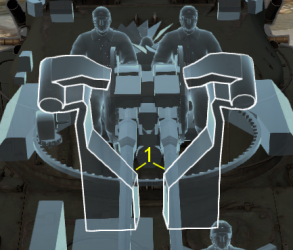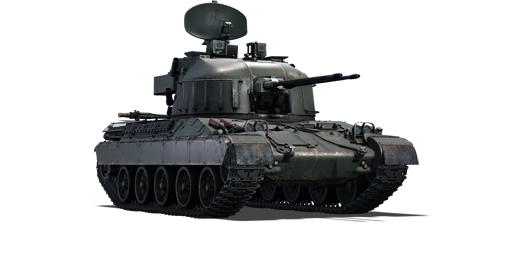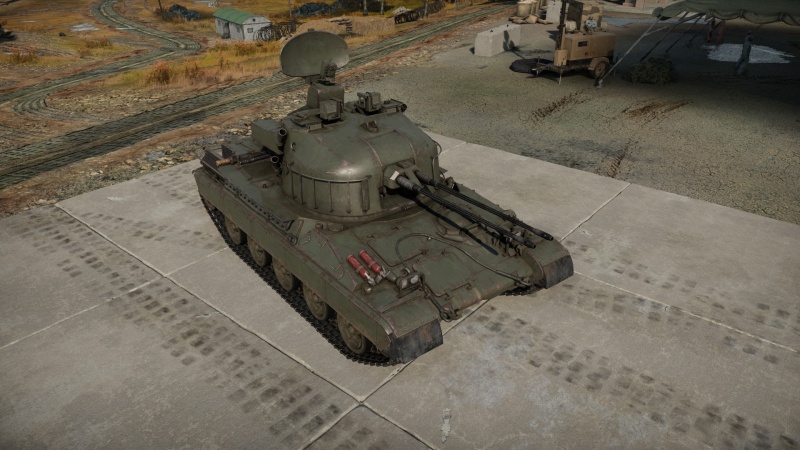AMX-30 S DCA
| This page is about the French self-propelled anti-aircraft vehicle AMX-30 S DCA. For other uses, see AMX-30 (Family). |
Contents
Description
The AMX-30 S DCA is a rank VI French self-propelled anti-aircraft vehicle with a battle rating of 8.7 (AB/RB/SB). It was introduced in Update 1.75 "La Résistance".
General info
Survivability and armour
The AMX-30 DCA is based off the hull of the AMX-30 main battle tank, resulting in a decently armoured hull. The front glacis is heavily sloped and capable of bouncing most APHE shells and, with luck, some HEAT shells. However, the hull sides and rear are fairly weak, coming in at only 25-30 mm thick.
The turret is more modestly armoured, with 20 to 30 mm of armour. This is sufficiently strong enough to withstand 20 mm or 23 mm cannon fired from an angle, allowing you to shoot down enemy aircraft trying to strafe you.
Crew placement is fairly average, as the driver is in the center of the hull while the gunner and commander sit on the opposite side of the guns. However, the placement of the ammunition feed at the front of the turret means any penetrating shot has a significant chance of causing an ammunition detonation.It is not advised to take less ammunition, as the 30 mm cannons have a high fire rate.
Mobility
As with the AMX-30, the AMX-30 DCA has a decent top speed of 60 km/h, along with an excellent set of reverse gears. This allows the DCA to keep up with its team, in addition to the ability to quickly escape danger.
However, note that the DCA lacks neutral steering and is somewhat slow to accelerate stock, meaning that it is possible to get caught off-guard and react too slowly.
| Game Mode | Max Speed (km/h) | Weight (tons) | Engine power (horsepower) | Power-to-weight ratio (hp/ton) | |||
|---|---|---|---|---|---|---|---|
| Forward | Reverse | Stock | Upgraded | Stock | Upgraded | ||
| Arcade | 71 | 71 | 36 | 994 | 1,240 | 27.61 | 34.44 |
| Realistic | 66 | 66 | 619 | 650 | 17.19 | 18.06 | |
Modifications and economy
Armaments
Main armament
The armament consists of 2 x 30 mm HSS 831A cannons with 300 RPG with a quick, fixed fire rate and can make use of 3 types of munitions:
- High-explosive incendiary (self-destroying, note that the self-destruction range coincides with the radar's lead indicator maximum distance, making the shell inadequate at longer ranges)
- Armour-piercing incendiary tracer, which can be used against lightly armoured vehicles and enemy SPAAs, though the damage to enemy aircraft is reduced, the shell can be used outside radar range since it does not self destruct.
- High-velocity armour-piercing tracer (APDS), which can be used against targets mentioned above and additionally, can be used to attack the side profile of enemy MBTs with reasonable effectiveness.
| 30 mm HSS 831A (x2) | Turret rotation speed (°/s) | Reloading rate (seconds) | ||||||||||||
|---|---|---|---|---|---|---|---|---|---|---|---|---|---|---|
| Mode | Capacity (Belt) | Fire rate | Vertical | Horizontal | Stabilizer | Stock | Upgraded | Full | Expert | Aced | Stock | Full | Expert | Aced |
| Arcade | 1,200 (300) | 600 | -5°/+85° | ±180° | N/A | 70.4 | 97.5 | 118.4 | 130.9 | 139.3 | 65.00 | 57.50 | 53.00 | 50.00 |
| Realistic | 47.6 | 56.0 | 68.0 | 75.2 | 80.0 | |||||||||
Ammunition
- Default: SAP-I · HEI-T*
- 30x170 HE-I-T: HEI-T* · HEI* · HEI* · SAP-I
- 30x170 APHE-I: SAP-I · SAP-I · SAP-I · HEI-T*
- 30x170 APDS-T: APDS · SAP-I · SAP-I · HEI-T*
| Penetration statistics | ||||||
|---|---|---|---|---|---|---|
| Belt | Penetration @ 0° Angle of Attack (mm) | |||||
| 10 m | 100 m | 500 m | 1,000 m | 1,500 m | 2,000 m | |
| Default | 53 | 50 | 39 | 29 | 21 | 16 |
| 30x170 HE-I-T | 53 | 50 | 39 | 29 | 21 | 16 |
| 30x170 APHE-I | 53 | 50 | 39 | 29 | 21 | 16 |
| 30x170 APDS-T | 110 | 101 | 95 | 69 | 52 | 41 |
Ammo racks

| Full ammo |
Ammo type |
1st rack empty |
Visual discrepancy |
|---|---|---|---|
| 4 1,200 |
Clips Rounds |
0 (+4) | Yes |
Notes:
- Ammunition is divided into 4 clips of 300 rounds.
- The visual discrepancy concerns the number of clips: 4 clips can be fired but only 2 are modeled.
Radars
The AMX-30 DCA is equipped with a DR-VC-1A combined search and tracking radar. The radar is located at the rear of the turret and cannot be folded. The radar system but can only track targets within a 200° arc from the front of the turret.
| DR-VC-1A - Target Detection Radar | ||||
|---|---|---|---|---|
| Maximum Detection Range |
Minimum Detection Range |
Max Azimuth Scan Angle |
Max Elevation Scan Angle |
Minimum relative speed |
| 15,000 m | 1,000 m | 360° | ??? | 15 m/s (54 km/h) |
| Albis - Target Tracking Radar | ||||
| Maximum Tracking Range |
Minimum Tracking Range |
Azimuth Tracking Angle |
Elevation Tracking Angle |
Minimum target speed |
| 15,000 m | 75 m | ±100° | -20°/+85° | 15 m/s (54 km/h) |
- Note: lead indicator shows up within 4km
Usage in battles
Anti-Air
Ideally, you should be in a place with horizontal cover against tanks and a wide field of view. Use the radar to spot incoming enemy aircraft. Lock onto the target within 4-5 kilometers in order to keep track of it, making sure to not fire.
For larger 2-4 engined aircraft, firing at 3 km may be effective. However, more agile single-engined fighters and most jet aircraft will be easily able to dodge incoming fire, meaning that you should wait until they close to 2 km before firing.
Fire in short bursts of 10-50 rounds each to avoid overheating and ammunition shortage. Moving the aim point around during the burst may help to disperse shots and increase hit probability, as even a single 30 mm HEI shell is deadly to most aircraft.
Keep in mind that the tracking radar does not work well at low altitudes, and will periodically stop tracking a target in order to scan for more incoming planes.
Anti-Tank
If forced into an anti-tank role, the AMX-30 DCA should be played as a support vehicle. With only 53 mm of penetration stock, it is unable to kill anything but IFVs and other SPAA. However, the 30 mm API and HEI rounds are incredibly potent at destroying tracks and damaging barrels, enabling you to assist teammates in killing tanks.
If facing enemy tanks alone, make sure that they are isolated before attempting to disable them.
Ideally, the enemy should be unaware of you and be flat-on (i.e perpendicular). From there, check to see if your belt has enough penetration to overcome his side armour. If it does, aim to take out his gun first (shoot directly below the turret), then his crew (driver's compartment, any survivors in the turret).
- Note that most Soviet MBTS like the T-55 or T-62 have 80 mm of side armour, meaning that they should be avoided when stock
- Other notable opponents include the M60 and Chieftain series of tanks, as they too have enough side armour to protect against the stock belt.
Pros and cons
Pros:
- Fast rate of fire, generally 50-100 RPM higher compared to other 30-35 mm gun SPAA
- The placement of the three crew members makes taking out the whole crew next to impossible with one shot
- Hull front of AMX-30 can sometimes block or deflect APHE
- Very fast considering its hull armour level, unlike the Chieftain Marksman
- Double or even triple the amount of ammunition, when compared to other 30-35 mm gun SPAA
- Gun arrangement makes it much easier to use against ground targets than the Gepard-style SPAAs
- Has radar, unlike some SPAA like the Falcon and M163
- Stock belts, but especially the APDS belts, chew through lightly armoured medium tanks like the Leopard's and light tanks like the BMP's
- Access to smoke grenades and ESS
- Night vision is available - no thermals however
- Extremely deadly to enemy ground vehicles in flanking manoeuvres
Cons:
- Can only take out light and sometimes medium tanks due to the small size of its guns
- Lightly armoured turret, with ammunition being very vulnerable to direct attacks
- Gun placement makes firing over ridges and hiding behind cover awkward
- Slow acceleration and lack of neutral steering hinders responsiveness
- Reloading the guns, switching ammunition belts or clearing jammed guns takes over a minute to complete, leaving you vulnerable and out of the action for a very, very long time
- Slow to accelerate in reverse
History
The development of the AMX-30 DCA (also known as the AMX-30SA) began in the year 1969 and it was derived from the AMX-13 DCA, a similar system produced for the French army. While the AMX-30 DCA was made for the French Army, it was also made for export and in the end, none of the DCA's were ordered by the French army. Instead, Saudi Arabia ordered an improved version in the 1975, called the AMX-30SA which included the SA-10 Shaline missiles.
It was developed to be used against low-flying aircraft and low-altitude attacks with its two Hispano-Suiza 30 mm 831 A automatic guns coupled to an Oeil-noir fire control system. This system had already been installed on the AMX-13, in lieu of a heavier chassis, using a turret designated the S 401 A. Although this vehicle began production in the year 1962, the introduction of the AMX-30 meant that the S 401 A turret could be mounted onto a much larger chassis which improved the agility of the vehicle. It also provided a much more stable platform and with double the ammo capacity of 1,200 rounds instead of the 600 that the AMX-13 could carry.
The guns were designed to shoot in bursts of 5 rounds, or even 15 rounds per burst with the cyclic rate of fire of 650 rounds a minute. They were controlled by an analogue computer that received information from a Doppler radar, which could be folded into an armoured box when not in use to protect from damage. The fire control depended on visual tracking, meaning it could not be used in night time.
Media
- Skins
- Videos
See also
Links to the articles on the War Thunder Wiki that you think will be useful for the reader, for example:
- reference to the series of the vehicles;
- links to approximate analogues of other nations and research trees.
External links
| France anti-aircraft vehicles | |
|---|---|
| Wheeled/Half-tracked | P.7.T AA · CCKW 353 AA · TPK 6.41 |
| AMX-13 Derivatives | VTT DCA · AMX-13 DCA 40 |
| Radar SPAAG | AMX-30 S DCA |
| Missile SPAA | SANTAL · Roland 1 · ▄ItO 90M |
| Other | AMX-10P |





